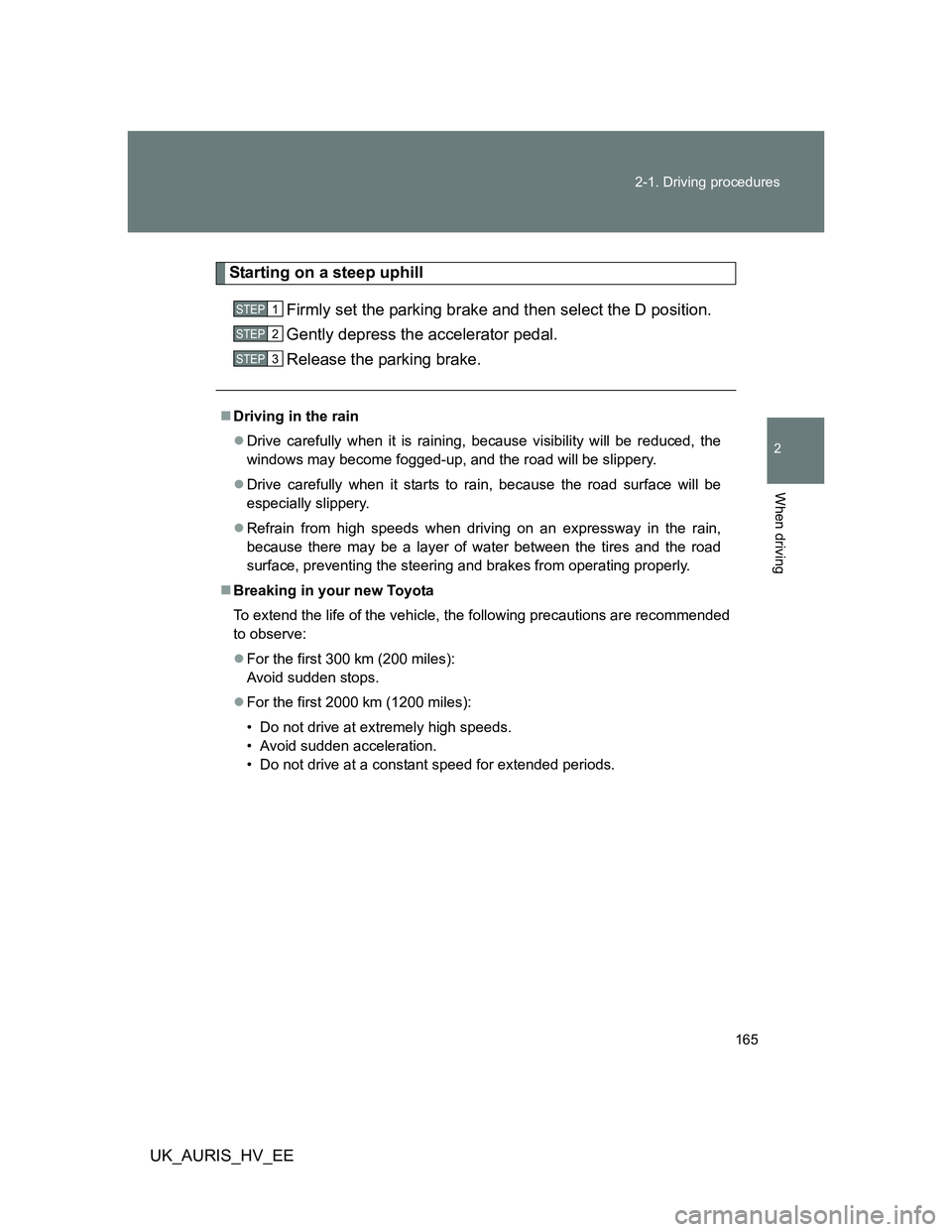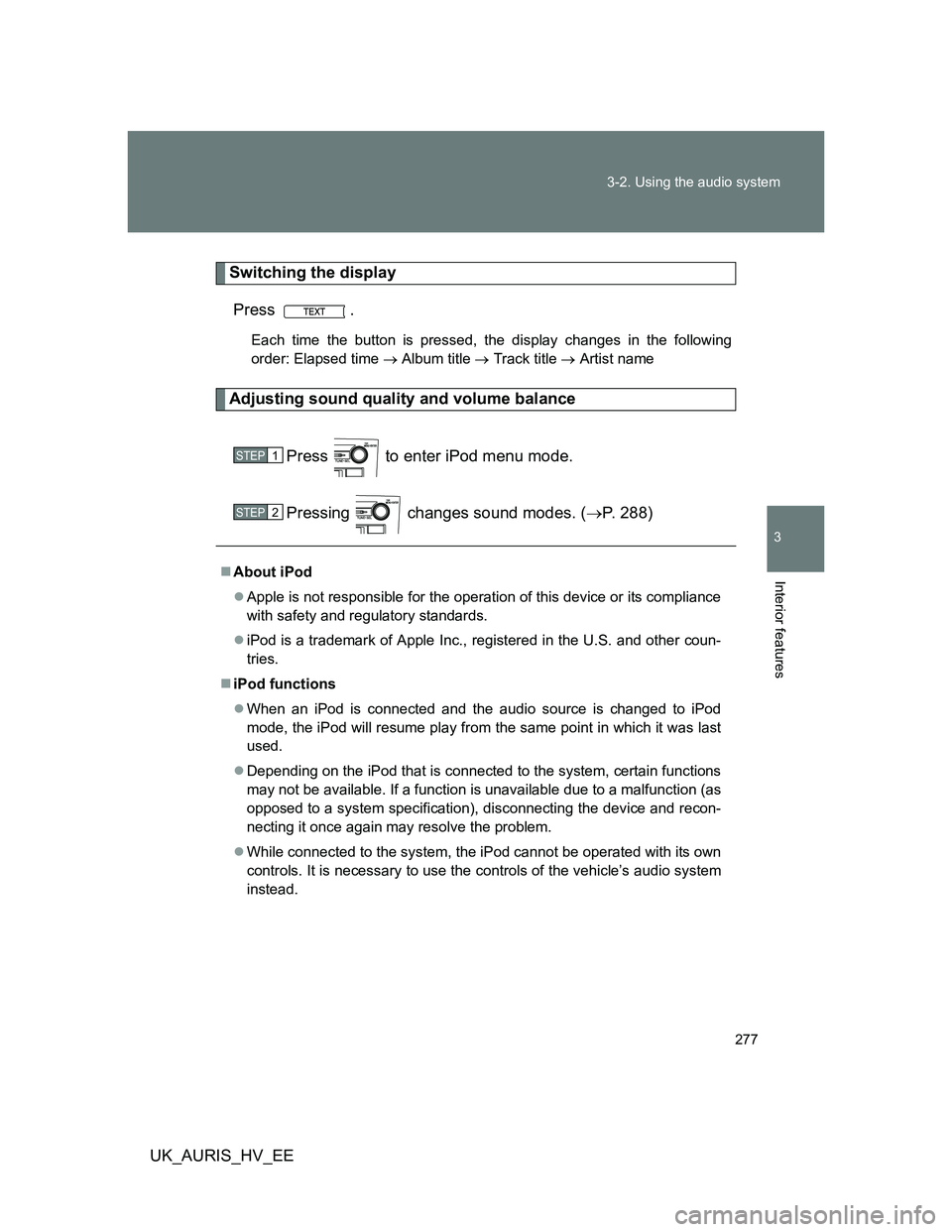Page 165 of 524

165 2-1. Driving procedures
2
When driving
UK_AURIS_HV_EE
Starting on a steep uphill
Firmly set the parking brake and then select the D position.
Gently depress the accelerator pedal.
Release the parking brake.
Driving in the rain
Drive carefully when it is raining, because visibility will be reduced, the
windows may become fogged-up, and the road will be slippery.
Drive carefully when it starts to rain, because the road surface will be
especially slippery.
Refrain from high speeds when driving on an expressway in the rain,
because there may be a layer of water between the tires and the road
surface, preventing the steering and brakes from operating properly.
Breaking in your new Toyota
To extend the life of the vehicle, the following precautions are recommended
to observe:
For the first 300 km (200 miles):
Avoid sudden stops.
For the first 2000 km (1200 miles):
• Do not drive at extremely high speeds.
• Avoid sudden acceleration.
• Do not drive at a constant speed for extended periods.
STEP1
STEP2
STEP3
Page 168 of 524

168 2-1. Driving procedures
UK_AURIS_HV_EE
CAUTION
When starting the vehicle
Always keep your foot on the brake pedal while stopped with the hybrid sys-
tem operating. This prevents the vehicle from creeping.
When driving the vehicle
Do not drive if you are unfamiliar with the location of the brake and accel-
erator pedals to avoid depressing the wrong pedal.
• Accidentally depressing the accelerator pedal instead of the brake
pedal will result in sudden acceleration that may lead to an accident
that could result in death or serious injury.
• When backing up, you may twist your body around, leading to a diffi-
culty in operating the pedals. Make sure to operate the pedals properly.
• Make sure to keep a correct driving posture even when moving the
vehicle only slightly, allowing you to depress the brake and accelerator
pedals properly.
• Depress the brake pedal using your right foot. Depressing the brake
pedal using your left foot may delay response in an emergency, result-
ing in an accident.
The driver should pay attention to pedestrians when the vehicle is pow-
ered only by the electric motor (traction motor). Because there is no hybrid
system sounds, the pedestrians may misjudge the vehicle’s movement.
Do not drive the vehicle over or stop the vehicle near flammable materials.
The exhaust system and exhaust gases can be extremely hot. This may
cause a fire if there is any flammable material nearby.
Do not let the vehicle roll backwards while a forward driving position is
selected, or roll forward while R is selected.
Doing so may cause the hybrid system not to operate or lead to poor
brake and steering performance, resulting in an accident or damage to the
vehicle.
Page 186 of 524
186 2-1. Driving procedures
UK_AURIS_HV_EE
Selecting a driving mode
The following modes can be selected to suit driving conditions.
Eco drive mode
Use Eco drive mode to help achieve low fuel consumption during trips
that involve frequent accelerating and braking. The operation of the air
conditioning system will be minimized.
Press the “ECO MODE” switch once more to cancel the Eco drive
mode.
Eco drive mode will not be canceled until the “ECO MODE” switch is
pressed, even if the “POWER” switch is turned off.
Press the “PWR MODE” switch to change the driving mode to power
mode.
Power mode
Use when high levels of response and feeling are desirable, such as
when driving in mountainous regions or when overtaking.
Press the “PWR MODE” switch once more to cancel the power mode.
Turning the “POWER” switch off will cancel power mode.
Press the “ECO MODE” switch to change the driving mode to Eco drive
mode.
Page 205 of 524
205 2-2. Instrument cluster
2
When driving
UK_AURIS_HV_EE
When disconnecting and reconnecting 12-volt battery terminals
The following information data will be reset.
Date
Average fuel consumption
Driving range
Average vehicle speed
Elapsed time
Outside temperature display
In the following situations, the correct outside temperature may not be dis-
played, or the display may take longer than normal to change.
When stopped, or driving at low speeds (less than 25 km/h [16 mph])
When the outside temperature has changed suddenly (at the entrance/
exit of a garage, tunnel, etc.)
NOTICE
The multi-information display at low temperatures
Allow the interior of the vehicle to warm up before using the liquid crystal
information display. At extremely low temperatures, the information display
monitor may respond slowly, and display changes may be delayed.
Page 228 of 524

228
2-4. Using other driving systems
UK_AURIS_HV_EE
Driving assist systems
To help enhance driving safety and performance, the following sys-
tems operate automatically in response to various driving situations.
Be aware, however, that these systems are supplementary and
should not be relied upon too heavily when operating the vehicle.
ABS (Anti-lock Brake System)
Helps to prevent wheel lock when the brakes are applied suddenly, or if
the brakes are applied while driving on a slippery road surface.
Brake assist
Generates an increased level of braking force after the brake pedal is
depressed, when the system detects a panic stop situation.
VSC (Vehicle Stability Control)
Helps the driver to control skidding when swerving suddenly or turning
on slippery road surfaces.
VSC+ (Vehicle Stability Control+)
Provides cooperative control of the ABS, TRC, VSC and EPS.
Helps to maintain directional stability when swerving on slippery road
surfaces by controlling steering performance.
TRC (Traction Control)
Helps to maintain drive power and prevent the front wheels from spin-
ning when starting the vehicle or accelerating on slippery roads.
Hill-start assist control
P. 232
EPS (Electric Power Steering)
Employs an electric motor to reduce the amount of effort needed to turn
the steering wheel.
Page 252 of 524
252
UK_AURIS_HV_EE
3-2. Using the audio system
Audio system types
: If equipped
Without “touch screen”
CD player with changer controller and AM/FM radio
TitlePage
Using the radioP. 257
Using the CD playerP. 262
Playing back MP3 and WMA discsP. 267
Operating an iPodP. 273
Operating a USB memoryP. 280
Optimal use of the audio systemP. 288
Using the AUX portP. 291
Using the steering wheel audio switchesP. 292
Page 257 of 524
257
3-2. Using the audio system
3
Interior features
UK_AURIS_HV_EE
Using the radio
Setting station presets
Manually
Search for desired stations by turning or pressing “
”
or “” on .
Press and hold the button (from to
) the station is
to be set to until you hear a beep.
: If equipped
Vo lu m e
Automatic presetting
of radio stationsStation selector
AF mode button TA mode button
Seeking the frequencyAdjusting the
frequency
AM/FM mode
buttonsChanging the
program typesPower
STEP1
STEP2
Page 277 of 524

277 3-2. Using the audio system
3
Interior features
UK_AURIS_HV_EE
Switching the display
Press .
Each time the button is pressed, the display changes in the following
order: Elapsed time Album title Track title Artist name
Adjusting sound quality and volume balance
Press to enter iPod menu mode.
Pressing changes sound modes. (P. 288)
About iPod
Apple is not responsible for the operation of this device or its compliance
with safety and regulatory standards.
iPod is a trademark of Apple Inc., registered in the U.S. and other coun-
tries.
iPod functions
When an iPod is connected and the audio source is changed to iPod
mode, the iPod will resume play from the same point in which it was last
used.
Depending on the iPod that is connected to the system, certain functions
may not be available. If a function is unavailable due to a malfunction (as
opposed to a system specification), disconnecting the device and recon-
necting it once again may resolve the problem.
While connected to the system, the iPod cannot be operated with its own
controls. It is necessary to use the controls of the vehicle’s audio system
instead.
STEP1
STEP2